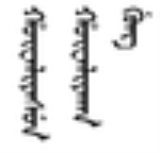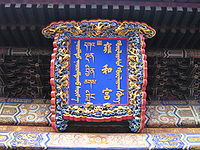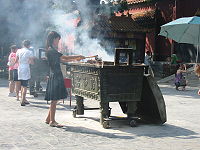
Yonghe Temple
Encyclopedia
The Yonghe Temple , also known as the "Palace of Peace and Harmony Lama Temple", the "Yonghe Lamasery", or - popularly - the "Lama Temple" is a temple and monastery of the Geluk School of Tibetan Buddhism
located in the northeastern part of Beijing
, China
. It is one of the largest and most important Tibetan Buddhist monasteries in the world. The building and the artworks of the temple combine Han Chinese
and Tibetan styles.
. It originally served as an official residence for court eunuchs. It was then converted into the court of the Prince Yong (Yin Zhen), a son of the Kangxi Emperor
and himself the future Yongzheng Emperor
. After Yongzheng's ascension to the throne in 1722, half of the building was converted into a lamasery, a monastery for monks of Tibetan Buddhism. The other half remained an imperial palace.
After Yongzheng's death in 1735, his coffin was placed in the temple. The Qianlong Emperor
, Yongzheng's successor, gave the temple imperial status signified by having its turquoise tiles replaced with yellow tiles which were reserved for the emperor. Subsequently, the monastery became a residence for large numbers of Tibetan Buddhist monks from Mongolia
and Tibet
, and so the Yonghe Lamasery became the national centre of Lama administration.
The temple is said to have survived the Cultural Revolution
due to the intervention of Prime Minister Zhou Enlai
. It was reopened to the public in 1981.



 The Yonghe Temple is arranged along a north-south central axis, which has a length of 480m. The main gate is at the southern end of this axis. Along the axis, there are five main halls which are separated by courtyards: the Hall of the Heavenly Kings (Tian Wang Dian or Devaraja Hall), the Hall of Harmony and Peace (Yonghegong), the Hall of Everlasting Protection (Yongyoudian), the Hall of the Wheel of the Law (Falundian), and the Pavilion of Ten Thousand Happinesses (Wanfuge).
The Yonghe Temple is arranged along a north-south central axis, which has a length of 480m. The main gate is at the southern end of this axis. Along the axis, there are five main halls which are separated by courtyards: the Hall of the Heavenly Kings (Tian Wang Dian or Devaraja Hall), the Hall of Harmony and Peace (Yonghegong), the Hall of Everlasting Protection (Yongyoudian), the Hall of the Wheel of the Law (Falundian), and the Pavilion of Ten Thousand Happinesses (Wanfuge).
The Hall of the Heavenly Kings is the southernmost of the main halls, it served originally as the main entrance to the monastery. In the center of the hall stands a statue of the Maitreya Buddha, along the walls statues of the four Heavenly Kings
are arranged.
The Hall of Harmony and Peace is the main building of the temple. It houses three bronze
statues of the Buddhas of the Three Ages, the statue of the Gautama Buddha
(Buddha of the Present) is in the center, it is flanked by the statue of Kasyapa Matanga
(Buddha of the Past, right) and the Maitreya Buddha (Buddha of the Future, left). Along the sides of the hall, the statues of the 18 Arhats are placed. A mural in the hall shows the bodhisattva
Avalokitesvara
.
The Hall of Everlasting Protection was Emperor Yongzheng's living quarters as a prince and the place where his coffin was placed after his death. Today, a statue of the Bhaisajya-guru (healing Buddha) stands in this hall.
The Hall of the Wheel of the Law functions as a place for reading scriptures and conducting religious ceremonies. It contains a large statue of Je Tsongkhapa
, founder of the Geluk School. The hall also contains the Five-Hundred-Arhat-Hill, a carving made of red sandalwood
with statues of the arhats made from five different metals (gold, silver, copper, iron, and tin).
The Pavilion of Ten Thousand Happinesses contains an 26m tall statue of the Maitreya Buddha carved from a single piece of White Sandalwood
. The statue is one of three artworks in the Temple which were included in the Guinness Book of Records in 1993.
, near the northeastern corner of the Second Ring Road. Lines 2
and 5
of the Beijing Subway
both stop at Yonghegong
, as do a number of city buses. The postal address is: 12 Yonghegong Dajie, Beixinqiao, Dongcheng District, Beijing.
Tibetan Buddhism
Tibetan Buddhism is the body of Buddhist religious doctrine and institutions characteristic of Tibet and certain regions of the Himalayas, including northern Nepal, Bhutan, and India . It is the state religion of Bhutan...
located in the northeastern part of Beijing
Beijing
Beijing , also known as Peking , is the capital of the People's Republic of China and one of the most populous cities in the world, with a population of 19,612,368 as of 2010. The city is the country's political, cultural, and educational center, and home to the headquarters for most of China's...
, China
China
Chinese civilization may refer to:* China for more general discussion of the country.* Chinese culture* Greater China, the transnational community of ethnic Chinese.* History of China* Sinosphere, the area historically affected by Chinese culture...
. It is one of the largest and most important Tibetan Buddhist monasteries in the world. The building and the artworks of the temple combine Han Chinese
Han Chinese
Han Chinese are an ethnic group native to China and are the largest single ethnic group in the world.Han Chinese constitute about 92% of the population of the People's Republic of China , 98% of the population of the Republic of China , 78% of the population of Singapore, and about 20% of the...
and Tibetan styles.
History
Building work on the Yonghegong Temple started in 1694 during the Qing DynastyQing Dynasty
The Qing Dynasty was the last dynasty of China, ruling from 1644 to 1912 with a brief, abortive restoration in 1917. It was preceded by the Ming Dynasty and followed by the Republic of China....
. It originally served as an official residence for court eunuchs. It was then converted into the court of the Prince Yong (Yin Zhen), a son of the Kangxi Emperor
Kangxi Emperor
The Kangxi Emperor ; Manchu: elhe taifin hūwangdi ; Mongolian: Энх-Амгалан хаан, 4 May 1654 –20 December 1722) was the fourth emperor of the Qing Dynasty, the first to be born on Chinese soil south of the Pass and the second Qing emperor to rule over China proper, from 1661 to 1722.Kangxi's...
and himself the future Yongzheng Emperor
Yongzheng Emperor
The Yongzheng Emperor , born Yinzhen , was the fifth emperor of the Manchu Qing Dynasty and the third Qing emperor from 1722 to 1735. A hard-working ruler, Yongzheng's main goal was to create an effective government at minimal expense. Like his father, the Kangxi Emperor, Yongzheng used military...
. After Yongzheng's ascension to the throne in 1722, half of the building was converted into a lamasery, a monastery for monks of Tibetan Buddhism. The other half remained an imperial palace.
After Yongzheng's death in 1735, his coffin was placed in the temple. The Qianlong Emperor
Qianlong Emperor
The Qianlong Emperor was the sixth emperor of the Manchu-led Qing Dynasty, and the fourth Qing emperor to rule over China proper. The fourth son of the Yongzheng Emperor, he reigned officially from 11 October 1735 to 8 February 1796...
, Yongzheng's successor, gave the temple imperial status signified by having its turquoise tiles replaced with yellow tiles which were reserved for the emperor. Subsequently, the monastery became a residence for large numbers of Tibetan Buddhist monks from Mongolia
Mongolia
Mongolia is a landlocked country in East and Central Asia. It is bordered by Russia to the north and China to the south, east and west. Although Mongolia does not share a border with Kazakhstan, its western-most point is only from Kazakhstan's eastern tip. Ulan Bator, the capital and largest...
and Tibet
Tibet
Tibet is a plateau region in Asia, north-east of the Himalayas. It is the traditional homeland of the Tibetan people as well as some other ethnic groups such as Monpas, Qiang, and Lhobas, and is now also inhabited by considerable numbers of Han and Hui people...
, and so the Yonghe Lamasery became the national centre of Lama administration.
The temple is said to have survived the Cultural Revolution
Cultural Revolution
The Great Proletarian Cultural Revolution, commonly known as the Cultural Revolution , was a socio-political movement that took place in the People's Republic of China from 1966 through 1976...
due to the intervention of Prime Minister Zhou Enlai
Zhou Enlai
Zhou Enlai was the first Premier of the People's Republic of China, serving from October 1949 until his death in January 1976...
. It was reopened to the public in 1981.
Architecture and artworks




The Hall of the Heavenly Kings is the southernmost of the main halls, it served originally as the main entrance to the monastery. In the center of the hall stands a statue of the Maitreya Buddha, along the walls statues of the four Heavenly Kings
Four Heavenly Kings
In the Buddhist faith, the Four Heavenly Kings are four gods, each of whom watches over one cardinal direction of the world.The Kings are collectively named as follows:...
are arranged.
The Hall of Harmony and Peace is the main building of the temple. It houses three bronze
Bronze
Bronze is a metal alloy consisting primarily of copper, usually with tin as the main additive. It is hard and brittle, and it was particularly significant in antiquity, so much so that the Bronze Age was named after the metal...
statues of the Buddhas of the Three Ages, the statue of the Gautama Buddha
Gautama Buddha
Siddhārtha Gautama was a spiritual teacher from the Indian subcontinent, on whose teachings Buddhism was founded. In most Buddhist traditions, he is regarded as the Supreme Buddha Siddhārtha Gautama (Sanskrit: सिद्धार्थ गौतम; Pali: Siddhattha Gotama) was a spiritual teacher from the Indian...
(Buddha of the Present) is in the center, it is flanked by the statue of Kasyapa Matanga
Kasyapa Matanga
Kasyapa Matanga was an Indian Buddhist monk who is believed to have introduced Buddhism to China in the 1st century CE....
(Buddha of the Past, right) and the Maitreya Buddha (Buddha of the Future, left). Along the sides of the hall, the statues of the 18 Arhats are placed. A mural in the hall shows the bodhisattva
Bodhisattva
In Buddhism, a bodhisattva is either an enlightened existence or an enlightenment-being or, given the variant Sanskrit spelling satva rather than sattva, "heroic-minded one for enlightenment ." The Pali term has sometimes been translated as "wisdom-being," although in modern publications, and...
Avalokitesvara
Avalokitesvara
Avalokiteśvara is a bodhisattva who embodies the compassion of all Buddhas. He is one of the more widely revered bodhisattvas in mainstream Mahayana Buddhism....
.
The Hall of Everlasting Protection was Emperor Yongzheng's living quarters as a prince and the place where his coffin was placed after his death. Today, a statue of the Bhaisajya-guru (healing Buddha) stands in this hall.
The Hall of the Wheel of the Law functions as a place for reading scriptures and conducting religious ceremonies. It contains a large statue of Je Tsongkhapa
Je Tsongkhapa
Tsongkhapa , whose name means “The Man from Onion Valley”, was a famous teacher of Tibetan Buddhism whose activities led to the formation of the Geluk school...
, founder of the Geluk School. The hall also contains the Five-Hundred-Arhat-Hill, a carving made of red sandalwood
Sandalwood
Sandalwood is the name of a class of fragrant woods from trees in the genus Santalum. The woods are heavy, yellow, and fine-grained, and unlike many other aromatic woods they retain their fragrance for decades. As well as using the harvested and cut wood in-situ, essential oils are also extracted...
with statues of the arhats made from five different metals (gold, silver, copper, iron, and tin).
The Pavilion of Ten Thousand Happinesses contains an 26m tall statue of the Maitreya Buddha carved from a single piece of White Sandalwood
Sandalwood
Sandalwood is the name of a class of fragrant woods from trees in the genus Santalum. The woods are heavy, yellow, and fine-grained, and unlike many other aromatic woods they retain their fragrance for decades. As well as using the harvested and cut wood in-situ, essential oils are also extracted...
. The statue is one of three artworks in the Temple which were included in the Guinness Book of Records in 1993.
Location
The Yonghe Temple is located in Beijing's Dongcheng DistrictDongcheng District, Beijing
Dongcheng District is an urban district in Beijing covering the eastern half of Beijing's urban core. It is 24.7 square kilometres in area and has a population of 535,558 . Dongcheng District covers several important parts of Beijing...
, near the northeastern corner of the Second Ring Road. Lines 2
Line 2, Beijing Subway
Line 2 of the Beijing Subway is a rapid transit rail line that runs in a rectangular loop around the city centre. It traces the Ming Dynasty inner city wall, which was demolished and paved over by the 2nd Ring Road and Qianmen Avenue. It is second oldest and busiest of Beijing's subway lines and...
and 5
Line 5, Beijing Subway
Line 5 of the Beijing Subway was Beijing's first subway with a north-south route. It runs for 27.6 km, in a near straight line, just east of the city centre from Tiantongyuan North in Changping District to Songjiazhuang in Fengtai District. It entered into operation on October 2007. Line...
of the Beijing Subway
Beijing Subway
The Beijing Subway is a rapid transit rail network that serves the urban and suburban districts of Beijing municipality. It is owned by the city of Beijing and has two operators, the wholly state owned Beijing Mass Transit Railway Operation Corp., which operates 12 lines, and the Beijing MTR...
both stop at Yonghegong
Yonghegong Lama Temple Station
Yonghegong Lama Temple Station is an interchange station on Line 2 and Line 5 of the Beijing Subway....
, as do a number of city buses. The postal address is: 12 Yonghegong Dajie, Beixinqiao, Dongcheng District, Beijing.
Further reading
- Lessing, Ferdinand, and Gösta Montell. Yung-Ho-Kung, an Iconography of the Lamaist Cathedral in Peking: With Notes on Lamaist Mythology and Cult. Stockholm: 1942.
External links
- Lama Temple, Beijing
- Satellite photo of the Yonghe Temple, centered on the Hall of Everlasting Protection

